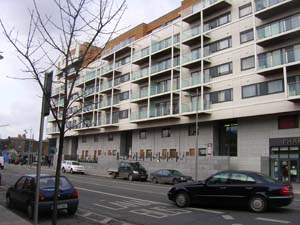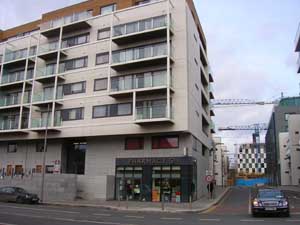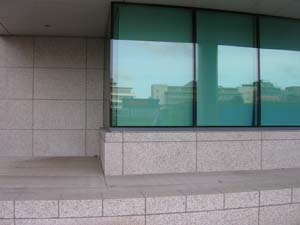Anne Street, Dublin City Center: A mixture of uses prevail in this pedestrian friendly, human-scaled street.

Anne Street, Dublin City Center: A mixture of uses prevail
in this pedestrian friendly, human-scaled street.
Dublin's city center provides an affable and increasingly active
street-oriented urbanism. Its medieval, organic roots underlie a more
formal 18th century Georgian aesthetic, which gives the city an elegant and coherent
irregularity. The city's streets and passages are lined with a steady cadence
of shopfronts, a messy mixture of uses integrated vertically and horizontally,
and enough street activity to inspire a revised version of Jane Jacobs' Hudson Street ballet. Indeed,
Dublin's famous
doors open to the street with a wonderful rhythm. People in, people out. It's a
beautiful thing to observe and an even better thing in which to to participate. That is
exactly what my girlfriend and I did on a recent vacation.
A walk across Dublin's historic center is a walk through a series of interconnected rooms. The city has a sense of controlled
breadth and a larger sense of volume through linear quays, symmetrical squares and even a few "geometrically aware" streets. Its cranky streets, tight lanes, and sweeping curves provide character and a warm feeling of enclosure. The collision of the two, where one grand room meets a small enclosed room, creates a punctuated sense
of arrival into each. The urban
energy hums in harmony with a constant ebb and flow between the two. This draws the urbanist from one place to the next, always in
pursuit of the city's next move. The rhythm is intoxicating.
The City's emerging Docklands district sings a more sobering song.
Ireland's meteoric economic rise in the past
decade is perhaps most tangible in a 1300 acre redevelopment district straddling the River
Liffey, just to the east of the city center. Aptly named,
it was once home to a large collection of derelict and undervalued maritime buildings. The same might be said for the area's residents, who until recently experienced a disproportionate amount of poverty and crime. Today the Docklands district represents the new face of Dublin; a truly international,
cosmopolitan city attracting everyone from eastern European immigrants to world renowned starchitects.
However, after visiting the city twice in the past two years and paying close attention to the progression of the Docklands, I have noticed that most of the development simply ignores the lessons of Dublin's wonderfully
urbane and diverse city center. Upon entering the district, one feels uttlery removed from Dublin's central vitality. Dead
spaces and blank facades create a monotonously sterile streetscape. Windswept plazas create an empty and impersonal urbanism. Such a stark departure from Dublin's vibrant core makes for a wholly
disappointing urban experience. To be clear, it is both a problem of architecture and urbanism -- not of style, but of substance. It's as if the new international style, seen on the edges of an increasing number of European cities, simply refuses to integrate the empirical evidence of successful urbanism.
Here are just a few key statistics as outlined
by the Docklands Development Authority, launched in 1997:
- Development Area - 520 ha
(1300 acres) - 92.9 acres (37.2 ha) under
S25 Planning Schemes - 15 year development period
(1997-2012) - Total public and private
investment estimated at €7 bn - Creation of 30,000-40,000 new
jobs - 11,000 new homes of which
2,200 (20%) are social and affordable - Population growth from 17,500
(1997) to 42,500 (2012) - Total development commenced
in 1st 5 years 380,000 m2
For more information, I invite you to study the 2003 Master Plan,
which is available from the Docklands Authority website. It details the motives for redevelopment and the rules of the game. Note in the urban design guidelines that any attempt to replicate Dublin's historic fabric is strongly discouraged. No wonder the place feels so cold.

Pearse Square: New residential development creates a
healthy contrast to Dublin's ubiquitous Georgian Townhouse.


Pearse Street, Docklands: For a primary street, the ground plane is poorly designed. Blank concrete walls give little to
the pedestrian experience and trump the convenience of the corner pharmacy (see right) and the potential for a walkable,
active block.

Grand Canal Square: The last hairs on a head gone bald or
a lifeless, overly designed public space? Maybe both?
Though a great prospect, this portion provides no refuge.
One cannot linger without a place to sit or an activity in which
to engage, or people to watch. As a result, people do not congregrate.

Sir Jon Rogerson's Quay: Greeting the street with office
space rarely works. From Miami to Dublin, I often see
ground-level office space covered in shades. How Boring!

Sir Jon Rogerson's Quay: Concrete berms, plantings and
shades do little to activate this potentially wonderful waterfront
thoroughfare. The march of banality continues. However,
note the physically-seperated bike lane striped in red.

North Wall Quay: Looking north across the Liffey, stiff
concrete and glass boxes arise from the industrial Dublin
Docklands. Heralded as a sustainable approach to urban
regeneration, can 'green' not also be humane?

Looking northeast, across the River Liffey, more development
to come.
All is not bad in the Docklands, and I do not want to be overly critical before the development has a chance to settle and grow into itself. Urbanism takes time. Nonetheless, I fear the leaders of this massive undertaking have, like so many before them, come down with a case of urban amnesia. Only time will tell.

Planetizen Federal Action Tracker
A weekly monitor of how Trump’s orders and actions are impacting planners and planning in America.

Chicago’s Ghost Rails
Just beneath the surface of the modern city lie the remnants of its expansive early 20th-century streetcar system.

Amtrak Cutting Jobs, Funding to High-Speed Rail
The agency plans to cut 10 percent of its workforce and has confirmed it will not fund new high-speed rail projects.

Ohio Forces Data Centers to Prepay for Power
Utilities are calling on states to hold data center operators responsible for new energy demands to prevent leaving consumers on the hook for their bills.

MARTA CEO Steps Down Amid Citizenship Concerns
MARTA’s board announced Thursday that its chief, who is from Canada, is resigning due to questions about his immigration status.

Silicon Valley ‘Bike Superhighway’ Awarded $14M State Grant
A Caltrans grant brings the 10-mile Central Bikeway project connecting Santa Clara and East San Jose closer to fruition.
Urban Design for Planners 1: Software Tools
This six-course series explores essential urban design concepts using open source software and equips planners with the tools they need to participate fully in the urban design process.
Planning for Universal Design
Learn the tools for implementing Universal Design in planning regulations.
Caltrans
City of Fort Worth
Mpact (founded as Rail~Volution)
City of Camden Redevelopment Agency
City of Astoria
City of Portland
City of Laramie






























